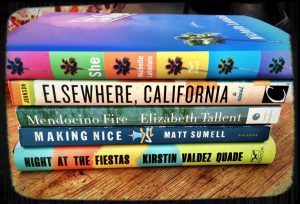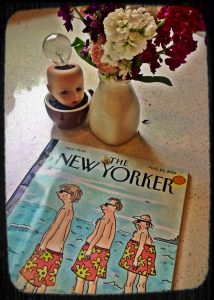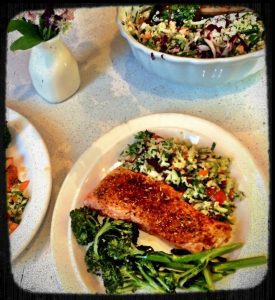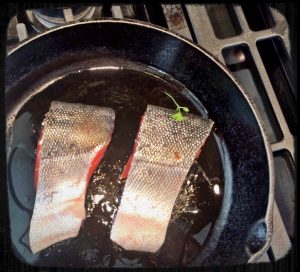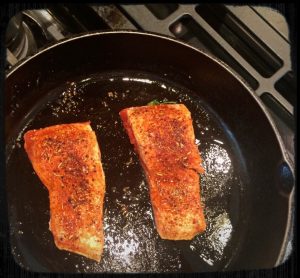Well, I’ve had two things happen since last you heard from me. First, I enrolled in a French class and it’s been wonderful. Currently we’re studying le marché. In every class we talk about food. Croissant, gateau, brioche, fromage, beurre, et les legumes. Consequently, J’ai faim tous les jours! The second thing, I had a medical procedure (I am well, no need for concern, but thank you) and when I woke from anesthesia, all I wanted was a croissant. Seriously, on the way home from the hospital, I insisted my husband stop á la boulangerie and buy me two, which I ate in bed, and, yes, there were crumbs.

read
I am SO into Margaret Atwood’s follow-up to The Handmaid’s Tale. The Testaments is fantastic thus far. Atwood uses three points of view to great effect. Each time we leave a narrator for someone else, I feel slightly robbed. I want to stay with narrator #1, but then, as soon as I get into narrator #2, I’m delighted. Same holds true for narrator #3. Honestly, this novel is damn good! If you’ve not read The Handmaid’s Tale, run out to pick it up. Don’t count on the fact that you’ve watched the show on Hulu. (Which, by the way, I have not. I don’t want to ruin the novel. If you think I’m making a mistake, please write to convince me.)
My husband and I went on a little road trip to Suttle Lake. We stayed at the Suttle Lodge, which I highly recommend, comfy, friendly and a damn good fish sandwich. On our drive we listened to Heartburn. Yes, that Heartburn! The old Nora Ephron chestnut narrated by Meryl Streep. It is a bit dated, everyone having nannies and live-in maids, making raspberry vinaigrette and discovering arugula. But man, it was funny and fun.

write
I don’t know about you, but I am signed up for quite a few newsletters. (Yes, I get that that is a slightly meta comment coming from me, as you are signed up for mine! Thank you! I hope you find it useful and entertaining.) I thought I might share a few that I enjoy. Literary Hub weekly is a great round up of articles and book reviews, commentary on what to read, when to read, why you shouldn’t self-publish your poetry, and many other great links. Creative NonFiction and Submittable have newsletters full of submission deadlines, and genre related news from around the web. I just started following eye level magazine, and I’m loving it. They have interesting articles, plus this gem, worth a follow for accounts to check out on Instagram. How about this one. Finally, The Paris Review has lots of newsletter options, daily, weekly, and the redux, which is full of pieces newly released from their archives.
For inspiration and thoughtful commentaries on all things life, try The Red Hand Files from Nick Cave. Here’s a quote from a recent missive:
“Tom Waits famously wrote “You are innocent when you dream”, yet dreams are not nearly as innocent as they seem. Neither are songs nor poetry. Songwriting and poetry are perilous callings, full of intrigue and infidelity. They are covert undertakings that creep around our deepest and most hazardous needs. They are not for the squeamish or the eager to please.”

eat
A long time ago, I was in love with the cookbooks of Patricia Wells. Now with my resurgent love of French, I’ve dug back into her oeuvre. Bistro Cooking, which came out in 1989, was a favorite of mine. The book is not a lifestyle book, it’s a straight up cookbook, full of great recipes from small family owned restaurants in France. Many may become your go to standards. Here’s a few of mine: onion soup, fig clafoutis, chicken in wine vinegar, broiled clams with garlic and parsley, ratatouille, and many delightful salads. In fact, I so want you to love her too, I’m including the best potato gratin in the world just for you and just in time for fall.
Gratin Dauphinois Madame Cartet
1 clove garlic, peeled and sliced in half
2 pounds white potatoes—I use Yukon Gold, she likes Russet. I’ve been known to use a mix of white and sweet potatoes
1 cup grated Gruyère
1 cup crème fraiche
1. Preheat the oven to 350º
2. Thoroughly rub a shallow 6 cup porcelain gratin dish with the garlic. Layer half of the potatoes in the dish. Sprinkle with half of the cheese and then half of the crème fraiche. Sprinkle with salt Add another layer of potatoes and the rest of the ingredients.
3. Bake uncovered, until the gratin is crisp and golden on top, from 50 – 60 minutes. Serve immediately.




